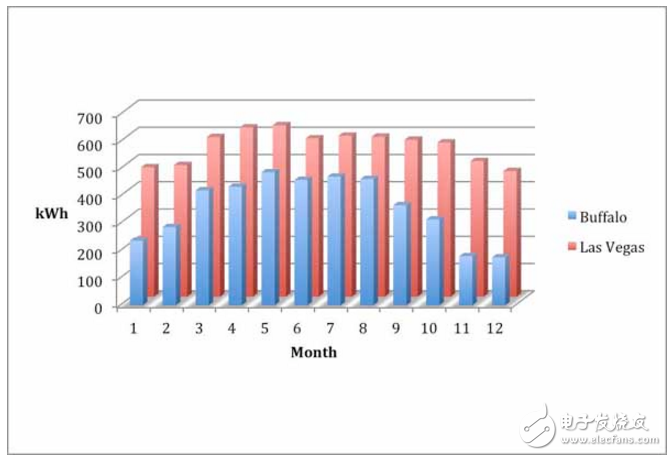
资料下载

变量设计时考虑太阳能发电的应用
变量设计时考虑太阳能发电的应用
太阳能电池板的能量输出取决于几个因素,包括面板的类型、太阳跟踪能力、位置、年的时间和一天中的时间(输出在一夜之间下降到零)。太阳能电池的最大性能随着时间的推移而变化,根据几个因素,输出通常会退化。对于设计工程师来说,要想最大限度地利用太阳能电池板产品,重要的是要考虑决定太阳能电池输出功率的物流要素,以及怎样才能最大限度地提取能量。
地球上并非每一个地方都有足够的运气,全年都能有很长的日照时间。但是内华达州是美国最著名的有连续阳光的地方之一,可能是最可靠的。也许这就是为什么美国空军(USAF)选择了内利斯空军基地作为其最大的光伏安装现场。在其完成2006,得利斯是世界上最大的光伏安装,一个14兆瓦的最大输出。但是峰值或最大输出规格只提供最好的情况。太阳的强度是变化的,即使在内华达州,太阳能电池的潜在输出功率也是如此,无论位置如何。

To put this in perspective, compare the typical output for two U.S. locations with very different solar input parameters. Las Vegas tops a list of major U.S. cities with 3,825 hours of sun over 210 clear days. At the bottom end is Buffalo, N.Y., with only 54 clear days and a total of 2,207 hours of sun. Using data supplied by the National Renewable Energy Laboratory (NREL), Figure 1 shows the expected monthly power output from a 4-kW installation with de-rating factors applied. Note the difference between locations. Even during the longest days of summer, a photovoltaic installation in Buffalo (and many other northeastern regions) can only achieve slightly less than 80 percent of the power output compared to similar 4-kW installations in Nevada.
声明:本文内容及配图由入驻作者撰写或者入驻合作网站授权转载。文章观点仅代表作者本人,不代表电子发烧友网立场。文章及其配图仅供工程师学习之用,如有内容侵权或者其他违规问题,请联系本站处理。 举报投诉
- 相关下载
- 相关文章







